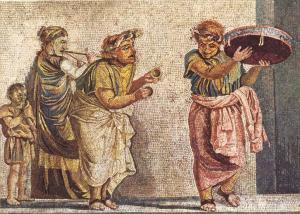
The works of the building that houses the Archeological Museum of Naples carried out between 1582 and 1586 by order of the Duke of Ossuna and designed by the architect Giulio Cesare Fontana. It had to be the Royal Riding School, but when they realized that there was no water in that place, the stable was abandoned. In 1615 it was inaugured as the "Palace of Royal Studies", the seat of the University of Naples. When the university moved elsewhere in 1777, King Ferdinand IV commissioned the restauration of the building from the architect Ferdinando Fuga in order to adapt it to accommodate the Bourbon Museum and Royal Library.
In 1797 this building housed the Herculaneum Museum, the Picture Gallery and the very famous Farnsese Collection which Charles of Bourbon inherited from his mother Elisabetta Farnese, wife of Philip, in 1731. During the XVIII and the XIX centuries the museum continued to receive a lot of artifacts, both from private collections and from excavations of Pompeii, Herculaneum, Stabiae, Paestum, Cuma or elsewhere in Southern Italy.
These archaeological treasures represent one of the most comprehensive and complete Greek and Roman collections in the world. The musuem could be divided into different sections:
Piazza Museo tel.081440166
orario :
feriali 9.00 - 19.30
festivi 9.00 - 19.30
la biglietteria chiude alle ore 18.00
chiuso il martedì
ingresso: euro 6,50 per i visitatori dai 18 ai 65 anni,gratuito per gli altri
The Naples Archaeological Museum is recognized as having the finest and most complete collection of works of art, objects and documentation from classical times. This collection includes over 20,000 items, produced according to object type and in inventory sequence. Items include bronzes, ceramics, sculpture, wall paintings, jewellery, terracotta items, objects in gold and silver, ivories, mosaics, utensils, Latin inscriptions and frescoes. The collection depicts portraits, still lives, mythical subjects, scenes from daily life, and erotic works of the museo segreto. It documents beliefs, personalities, religions and views of the outside world.